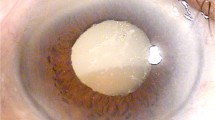Abstract
Background
A ‘double-ring’ sign may be seen during continuous curvilinear anterior capsulorhexis in cataract surgery. This sign has been attributed to partial splitting of the anterior lens capsule at the continuous curvilinear anterior capsulorhexis edge. Because horizontal intracapsular splits away from the capsule edge have also been reported, a double-ring sign has been hypothesized to be a precursor to true exfoliation. We report new histopathological findings for both anterior capsule and lens epithelium changes, the latter being similar to those of true exfoliation.
Methods
Three anterior capsules from two patients with a double-ring sign during capsulorhexis were examined via light and transmission electron microscopy.
Results
Light microscopy revealed step formations in the capsule edges and surface-parallel intracapsular splits in the anterior capsules. Transmission electron microscopy revealed stratified, banded structures consisting of alternating electron-dense and -lucent granular belts (300–400 nm) at the central area of the anterior capsule, as well as vacuole-like spaces and expansion of intercellular spaces in the lens epithelium.
Conclusions
The thickened, stratified structure of the anterior capsule suggests abnormal lens epithelium in patients with a double-ring sign. The horizontal splits in the anterior capsule, with concomitant epithelial changes, i.e., the vacuole-like spaces and widened intercellular spaces, support the relation between a double-ring sign and true exfoliation.








Similar content being viewed by others
References
Abe T, Hirata H, Hayasaka S (2001) Double-ring and double-layer sign of the anterior lens capsule during cataract surgery. Jpn J Ophthalmol 45:657–658
Asakawa H, Ijichi H, Ishiwata T (1994) Report of two cases with idiopathic true exfoliation of the lens capsule—histopathological and electron microscopical study (in Japanese). Nippon Ganka Gakkai Zasshi 98:664–671
Braude LS, Edward DP (1995) Partial splitting of the anterior lens capsule giving a ‘double-ring’ sign. Arch Ophthalmol 113:705–706
Karp CL, Fazio JR, Culbertson WW, Green WR (1999) True exfoliation of the lens capsule. Arch Ophthalmol 117:1078–1080
Shinjo M, Morine S, Kiriyama M, Sakai M (2000) Double-ring sign in the capsular edge following continuous curvilinear capsulorhexis (in Japanese). Jpn J Clin Opthalmol 54:251-254
Wollensak G, Wollensak J (1997) Double contour of the lens capsule edges after continuous curvilinear capsulorhexis. Graefes Arch Clin Exp Ophthalmol 235:204–207
Worgul BV (1991) Lens. In: Tasman W (ed) Biomedical foundations of ophthalmology, vol. 1. JB Lippincott, Philadelphia, p 1
Author information
Authors and Affiliations
Corresponding author
Rights and permissions
About this article
Cite this article
Ataka, S., Kohno, T., Kurita, K. et al. Histopathological study of the anterior lens capsule with a double-ring sign. Graefe's Arch Clin Exp Ophthalmol 242, 245–249 (2004). https://doi.org/10.1007/s00417-003-0814-6
Received:
Revised:
Accepted:
Published:
Issue Date:
DOI: https://doi.org/10.1007/s00417-003-0814-6




